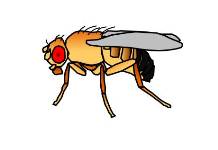X-Y coevolution

Male Drosophila melanogaster.
Research on speciation has made it clear that coevolution of the sex chromosomes with each other and with the rest of the genome is an important factor in reproductive isolation between species. But what about within species? Can we see signatures of X-Y coevolution on shorter timescales? We have selected 5 different genetically variable lab-adapted populations that are widely separated geographically (continental scale) and created reciprocal X-introgression and Y-introgression test genotypes in a round-robin design (i.e. X1Y2A2A2 and X2Y1A2A2, where A denotes autosomes and subscripts denote source population). The advantage of this approach is that sustained backcrossing is not necessary, since adaptation to the presence of a novel sex chromosome could occur during the backcrossing process. Because the Y chromosome does not recombine and has a smaller population size than the rest of the genome, we expected that it should accumulate mildly deleterious mutations that the X-Y chromosome should evolve to compensate for. If so, having a mis-matched X and Y should be bad for male fitness. Surprisingly, our results showed the opposite pattern. Males with novel sex chromosomes actually did better than normal males! Production of genotypes with matching sex chromosomes but autosomes from a different population (i.e. X1Y1A2A2) has confirmed that this effect can be explained by interactions between the sex chromosomes exclusively, in other words interactions between the sex chromosomes and the autosomes have no measurable effect.
The increased fitness in males with a novel X or Y seems to be driven by better performance in sperm competition. However this increased sperm competition success appears to have a downside in terms of reduced offspring survival. We therefore expect that genotypes with a novel sex chromosome should evolve back to the wildtype phenotype over time. Experimental evolution of our novel sex chromosome populations has confirmed this expectation.
Students: Katrine Lund-Hansen
Collaborators: Ted Morrow, University of Sussex
